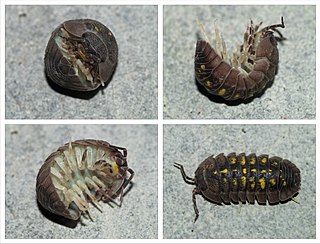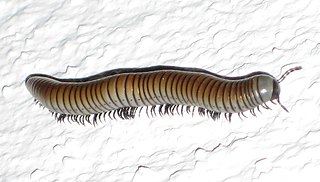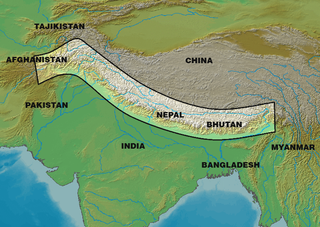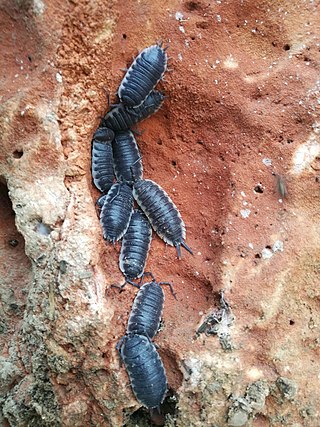
The plazas de soberanía is a term describing a series of Spanish overseas minor territories scattered along the Mediterranean coast bordering Morocco in Africa, or that are closer to Africa than Europe. This term is used for those territories that have been a part of Spain since the formation of the modern country (1492–1556), as opposed to African territories acquired by Spain during the 19th and early 20th centuries in the Scramble for Africa.

Armadillidiidae is a family of woodlice, a terrestrial crustacean group in the order Isopoda. Unlike members of some other woodlice families, members of this family can roll into a ball, an ability they share with the outwardly similar but unrelated pill millipedes and other animals. This ability gives woodlice in this family their common names of pill bugs or roly polies. Other common names include slaters,potato bugs, butchy boys and doodle bugs. Most species are native to the Mediterranean Basin, while a few species have wider European distributions. The best-known species, Armadillidium vulgare, was introduced to New England in the early 19th century and has become widespread throughout North America.

A woodlouse is any crustacean belonging to the suborder Oniscidea within the order Isopoda. They get their name from often being found in old wood, and from louse, a parasitic insect, although woodlice are not insects.

The Trictenotomidae are a small family of beetles in the superfamily Tenebrionoidea, containing fifteen species in two genera. Most species are found in the Oriental realm where they live in montane forest habitats. The family is considered, based on larval characters as well as sequence-based studies, to be closely related to the Salpingidae.

Heteronida is a genus of squat lobsters in the family Munididae. They occur in the western Pacific Ocean.

Torbenella is a genus of squat lobsters in the family Munididae. They occur in the western Pacific Ocean.

Ommatoiulus is a genus of millipedes in the family Julidae.

Armadillidae is a family of woodlice, comprising around 80 genera and 700 species. It is the largest family of Oniscidea, and one of the most species-rich families of the entire Isopoda. Armadillids generally have a strongly convex body shape, with some rather shallowly convex. Like members of the woodlice family Armadillidiidae, armadillids are capable of enrolling into a sphere (conglobation), and are commonly known as pill bugs. Armadillids differ from the Armadillidiidae in that the antennae are fully enclosed within the sphere.

Omethidae is a family of Elateroidea sometimes known as the false soldier beetles. They are native to South, Southeast and Eastern Asia and the Americas. Their biology is obscure and their larvae are unknown. They appear to inhabit vegetation in or surrounding forests, and are probably active during the day.

Parbatthorax is a small genus of Asian sheet weavers first described by A. V. Tanasevitch in 2019. As of April 2022 it contains only two species: P. proiectus and P. unicornis. Its appearance resembles members of Gongylidioides and Glebala, but it can be distinguished by the unique shape of its carapace and a highly modified palpal tibia and paracymbium. The genus name is a combination of the Parbat District, where the first specimen was found, and the "thorax", whose unique shape is one of its distinguishing factors.
Bavirecta is a genus of Asian jumping spiders first described by N. Kanesharatnam & Suresh P. Benjamin in 2018. As of April 2019 it contains only two species. It was placed in the tribe Baviini, part of the clade Salticoida of the subfamily Salticinae.
Lusitanipus is a genus of millipedes in the family Dorypetalidae. The genus is endemic to the Iberian peninsula; L. alternans is endemic to Portugal and L. xanin is only known from Spain. It was believed to be a monotypic genus until the 2020 discovery of L. xanin.
Dorypetalidae is a family of millipedes in the order Callipodida. The family contains at least 4 genera and about 10 species.
Sphegina granditarsis is a species of hoverfly in the family Syrphidae.
Sphegina hauseri is a species of hoverfly in the family Syrphidae.
Sphegina inventum is a species of hoverfly in the family Syrphidae.
Sphegina lucida is a species of hoverfly in the family Syrphidae.
Weygoldtia is a genus of amblypygids of the family Charinidae, described in 2018 by Gustavo Silva de Miranda, Alessandro P.L. Giupponi, Lorenzo Prendini and Nikolaj Scharff. The genus is named after the German arachnologist Peter Weygoldt, in recognition of his contributions to the study of Amblypygi.
Catageus is a genus of amblypygids of the family Charontidae.

Porcellio hoffmannseggii, commonly called the titan isopod, is a species of woodlouse of the genus Porcellio described in 1833. This very large species is native to the southern Iberian Peninsula, Morocco and the Balearic Islands.











